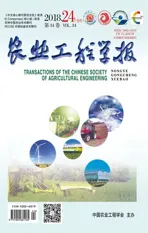螺带-螺杆式搅拌好氧堆肥反应器研制及应用效果
2019-01-14陈学好张瑞宏刘思幸
缪 宏,杨 铮,王 蒙,陈学好,张瑞宏,刘思幸
螺带-螺杆式搅拌好氧堆肥反应器研制及应用效果
缪 宏1,2,杨 铮1,王 蒙1,陈学好3,张瑞宏1,刘思幸1
(1. 扬州大学机械工程学院,扬州 225000;2. 农业部现代农业装备重点实验室,南京 210014; 3. 扬州大学园艺与植物保护学院,扬州 225000)
针对目前堆肥反应器存在的原料呈压实块状、通气性能差、通风阻力大、产品难以均质化等问题,设计了螺带-螺杆式好氧堆肥反应试验装置,采用计算流体力学方法对螺带-螺杆搅拌作用的搅拌流场进行了数值模拟分析,并进行了好氧堆肥性能试验。通过流场的数值模拟,揭示了螺杆-螺带式搅拌叶片对物料具有很好的搅拌及轴向流动性能,堆肥试验结果表明:上、中、下3层的50 ℃以上的时间分别为7.3、6.8、5.5 d,反应过程中氧气体积分数均大于8%,各层堆料的最终碳氮比介于15~20之间,发芽指数均大于88%,重金属含量符合农用标准的要求,因此该反应器可以实现好氧堆肥的无害化、均质化。
堆肥;装备;性能试验;螺带-螺杆;反应器
0 引 言
近年来,随着中国禽畜养殖业的快速发展,对生态环境造成了巨大挑战。据统计,目前中国的禽畜粪便产量约为38亿t,居全国重点污染排放领域之首[1]。利用好氧堆肥可实现这些有机固体废弃物的减量化、资源化和无害化处理[2-5],其可以分为包括静态堆肥、槽式堆肥、条垛式堆肥、反应器堆肥[6-7]等,其中,反应器的堆肥方式因其具有堆肥周期短、占地面积小、作业环境好等优点成为目前研究热点,具有良好的应用前景[8-10]。
目前国内外立式堆肥反应器发展较为成熟,好氧堆肥反应是一个“质量-热量-动量”的复杂传递过程[11-14],对于堆肥反应机理的基础研究尚不够深入,而目前可用于实验室模拟堆肥反应的试验装置如韩鲁佳、张安琪等研发的实验室小型堆肥反应装置[15-16]、Guillermo Vidriales-Escobar等研发的管状堆肥反应器[17]、Naoto Shimizu等研发处理牛粪堆肥的强制通风反应器[18]、Lashermes等设计的小型智能好氧堆肥反应器系统[19]等这些立式反应器结构简单,有效缩短堆肥反应时间,改善堆肥反应环境,但由于物料重力堆积作用,存在着原料呈压实块状、通气性能差、通风阻力大、产品难以均质化等缺点。
针对这些问题,本文研制螺带-螺杆式好氧堆肥反应器,较为详细地探讨了该反应装置的结构特点及其运行性能。
1 螺带-螺杆式好氧堆肥反应装置的设计
根据好氧堆肥过程的工艺特点设计试验装置,如图1所示,主要包括反应器物料舱、排气口、螺带-螺杆翻堆装置、传感器通道等部分组成。堆肥物料由入料口进入物料舱,在舱体内进行好氧堆肥反应,通过螺带-螺杆翻堆装置及曝气系统使物料与氧气充分接触,强化好氧堆肥反应的均匀性。
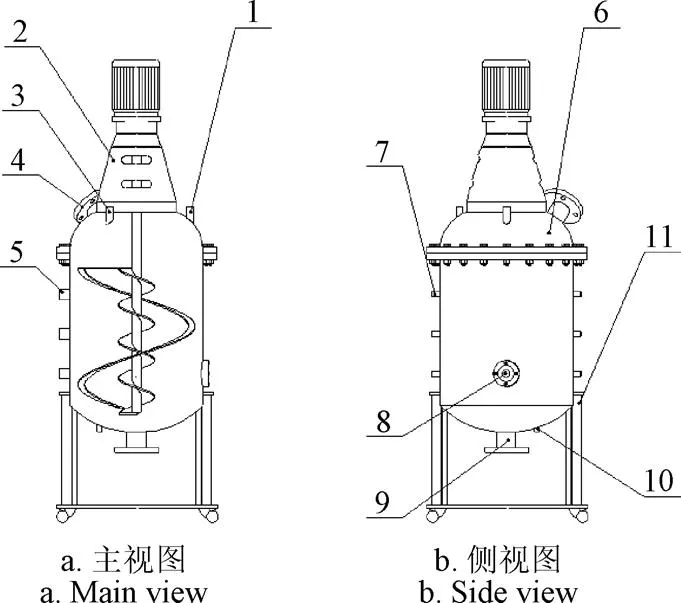
1.排气口 2.螺带-螺杆翻堆装置 3.补水口 4.入料口 5.温度传感器接口 6.物料舱 7.氧浓度传感器接口 8.可视观测口 9.出料口 10.曝气通道 11.支架
1.1 反应器容积及基本尺寸的确定
堆肥装置维持堆体温度的必要条件是[20]


确定设计参数为:当堆料中干基质为0时,环境温度为25 ℃,堆体的最高温度为55 ℃,物料的初始含水率M为60%,有机物质量比0.97 g/g,有机质含量降解率为35%,固体堆料比热容,1.05 kJ/( kg·℃)。引用参考文献[21-22]的相关公式计算得出堆料质量与有效表面积之比应满足o/>2.07。
由于该反应器是基于理论试验研究设计的,考虑堆肥实际过程、径高比、制造成本等因素,确定反应器有效容积为100 L。参考常见搅拌容器常用装料高径比[23-24],其内径为500 mm,高度L为600 mm,全部采用304不锈钢材质,并在其外围加一层厚度为20 mm的聚氨酯保温材料。在罐体表面距离底部150,300及450 mm位置处安装连接控制面板的温度传感器(PT100,北京九纯健科技有限公司)和氧浓度传感器(FDM700,北京九纯健科技有限公司)用于监测温度及氧浓度的变化。
1.2 螺带-螺杆搅拌装置设计
对于堆体物料的搅拌操作,其主要目的为混合、分散和流动,促进物质的移动和热交换。堆肥物料黏度高,在堆肥反应过程中,不同部位的堆体物料由于反应进程的不一致,存在着微生物数量和活性的差异[23],因此堆体存在着轴向的温差,影响反应速率。
本装置采用螺带-螺杆搅拌系统,如图2所示,螺带-螺杆的螺旋方向相反,具有很好的轴向流动作用。参考文献[24],容器内径与外螺带直径之比/D=0.95,考虑温度及氧浓度传感器的伸入量,确定主要参数如图2所示。
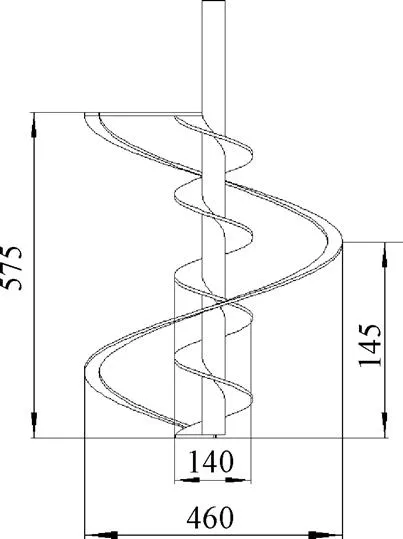
图2 螺带-螺杆搅拌叶片结构示意图
1.3 曝气系统设计
好氧堆肥反应主要参与的有机物可以分为含氮有机物(C12H16O6N)和非含氮有机物(C2H3O)[21],其反应式为


假设含氮有机物占非含氮有机物的20%,可知每千克挥发性固体需要氧气的质量为1.498 kg。堆肥试验过程中反应罐体装满4/5时,物料为44 kg,初试含水率为60%,有机质含量降解率35%,空气中氧气的质量分数为23.2%,标准状态下空气密度为1.207 kg/m3。
理论通风量air[15]为

式中M为反应器内的初始含水率,%;m为反应器内的堆料质量,kg;M为堆肥物料有机质含量,%;V为有机质降解率,%;o为空气中氧气的质量分数,%;a为空气的密度,kg/m3。
经计算air为23.06 m3,由于曝气系统采用间歇式通风模式,由于经折合计算,可得风机实际通风时间累计为12 d。计算得该阶段通风流量为1.33 L/min。
通风的另一功能是去除多余水分,通过计算出气口与进气口空气的湿度与水分蒸发量,由此得到去除水分所需的空气量。由文献[18-21]可得,在初始含水率为60%的情况下,堆肥过程中去除水分质量M为20.24 kg。因此每天的去除水分的量M为1.69 kg。由公式(5)计算去除水分所需的通风量cs(L/min)[25]。

式中为风机漏风系数;55为55 ℃饱和空气密度,kg/m3;55为55 ℃饱和空气含湿量,%;55为25 ℃饱和空气密度,kg/m3;25为25 ℃饱和空气含湿量,%。
计算可得,V为7.89 L/min,曝气系统的曝气量应为好氧堆肥反应需氧量和去除水分需氧量之和,即理论曝气流量应为9.22 L/min。
2 基于Fluent的螺带-螺杆搅拌流场分析
2.1 控制方程
假设搅拌槽内的堆肥物料在瞬态为不可压缩流体的湍流流动,不考虑温度的变化,其流动遵守质量守恒和动量守恒,用N-S方程及标准-方程来描述,即


式中为速度,m/s;为压力,Pa;为物料密度,kg/m3;为体积力,N;为堆肥物料黏度,Pa·s。
方程通过离散化处理后再定义边界条件,即可求解。
2.2 网格划分与设置边界条件
反应器内部流场模型的三维实体建模通过Soildworks造型设计完成,采用多重参考系法(multiple reference frame)来处理静止的反应器内壁和运动的搅拌叶片的相互作用[26],如图3所示,将计算区域分为互不重叠的3个部分,即区域1、区域2和区域3。计算时,区域1和区域3采用旋转坐标系,区域2采用静止坐标系,网格划分时,采用四面体结构化网格,其中区域1、区域2和区域3的网格总数分别为:136 846 8、132 492 8、890 270。

图3 区域1、区域2、区域3反应器网格划分情况
反应器壁面为无滑移边界条件,上端液面为自由液面,定义为对称的边界;螺带、螺杆区域旋转坐标系具有相同的角速度,对于立式好氧堆肥反应器,转速通常为20~60 r/min,而转速过快将减缓对菌剂的生长产生抑制作用[27],因此该反应器转速为40 r/min,方向为顺时针,搅拌桨叶相对于旋转坐标系为静止。设定反应器内部物料的黏度为32.5 Pa·s,密度为1 400 kg/m3。
2.3 计算结果
=0截面上的速度场分布和速度矢量图如图4所示,螺带与反应器内壁附近的流体一部分向反应器底部方向运动,而一部分流体由于桨叶背面产生低压的原因,出现了漩涡现象。在反应器中心处,与螺带相反旋向螺杆附近的流体形成了逆向的轴向流动,使堆肥物料有规律的循环流动,从而有助于增强了中心搅拌的能力,提高搅拌的均匀性和效率,实现堆肥物料的轴向循环。

图4 速度场分布图及速度矢量图
3 堆肥反应器性能试验
3.1 试验设计
以牛粪、麦秸秆为主要原料进行好氧堆肥试验,调理剂采用蘑菇渣。鲜牛粪取自扬州大学实验农牧场,麦秸秆取自扬州市朴席镇农田。将麦秸秆粉碎至1~2 cm,将牛粪、麦秸秆、蘑菇渣按照4:1:1的质量比混合,加入适当水分,将初始物料调至较优范围,堆肥原料及混合物料的理化特征表1所示。初始物料含水率为65.76%,碳氮比为28.53%,采用间歇式曝气搅拌方式,每12 h曝气搅拌1次。
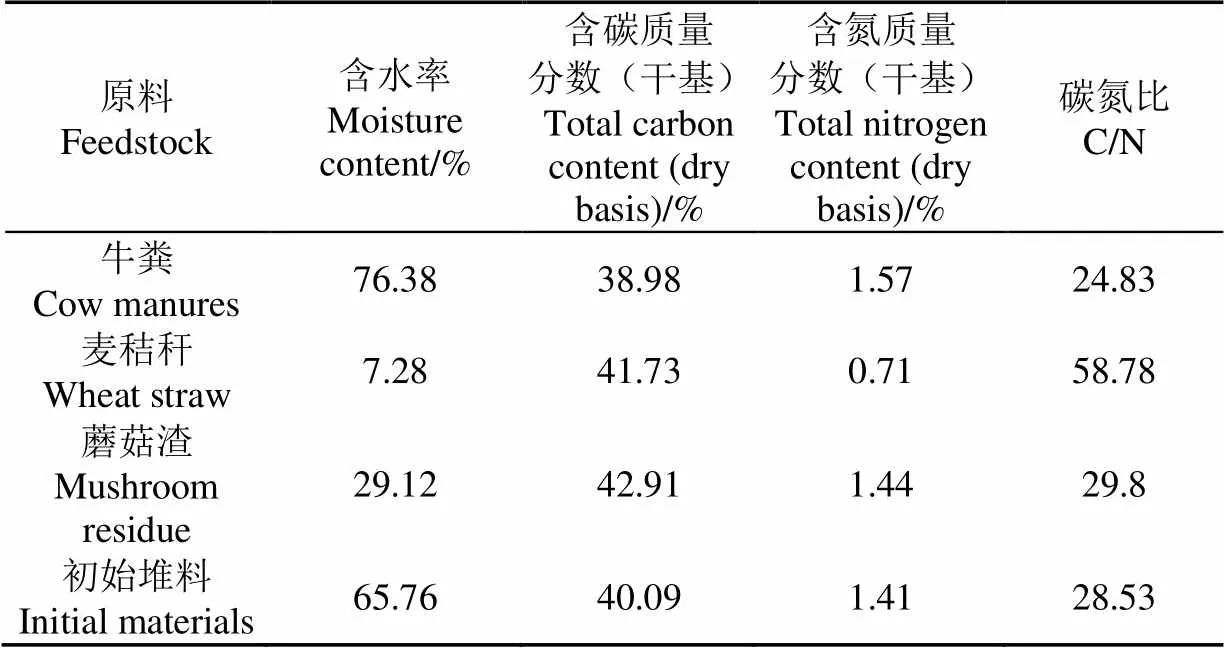
表1 初始堆肥物料理化指标
堆肥反应性能试验主要通过堆肥过程中,堆体上、中、下3个高度下的堆体温度、含氧量、含水率、全碳含量、全氮含量、碳氮比(C/N)、全磷含量、全钾含量、重金属总量和种子发芽指数(germination index,GI)来衡量堆肥反应器的性能。测定方法如下:堆体温度和氧浓度通过上、中、下传感器进行测量,取每天的平均值;含水率的测量采用文献[22]所用的常压干燥法,每2 d测量1次;总碳与总氮的含量采用元素分析仪(Vario EL cube,德国Elementar公司)进行测量,并计算碳氮比(C/N),全磷含量采用钼锑钪比色法(721分光光度计,波长700 nm),全钾含量采用火焰光度法[28],每两天取样1次;堆料的Cu、Zn、Cr、Pb、Cd重金属总量的测定采用葛骁等[29]的方法;种子发芽指数(GI)采用张安琪等[15]的方法,选用大豆种子(奇农1号,北京农科院),每5 d取样1次。
3.2 好氧堆肥过程中堆体物料温度变化
如图5所示,反应器上、中、下3层的温度,从图5中可看出,一开始堆体的温度上升非常迅速,在第4天时,上、中、下层的最高温度分别为65.9、63和62.1。随后堆体各层温度缓慢下降。上、中、下3层的50 ℃以上的时间分别为7.3、6.8、5.5 d,因此符合无害化堆肥处理[30]的要求,且各层差异较小。

图5 堆肥过程中堆体温度的变化曲线
3.3 好氧堆肥过程中堆体物料氧浓度变化
堆体的氧气浓度是衡量好氧堆肥发酵效果的重要参数[31],如图6所示,在堆肥初始阶段,氧气浓度快速下降,这是因为在这阶段好氧微生物呈现指数式增长,微生物的繁殖耗氧导致堆体中氧气浓度快速下降[32]。而在第6~12天期间,高温抑制了部分微生物的增长,氧气浓度逐渐上升。在15 d以后,氧气浓度趋于稳定。整个过程堆体氧气体积分数均大于8%,未形成厌氧区域,从而有助于抑制有害气体的产生[32]。
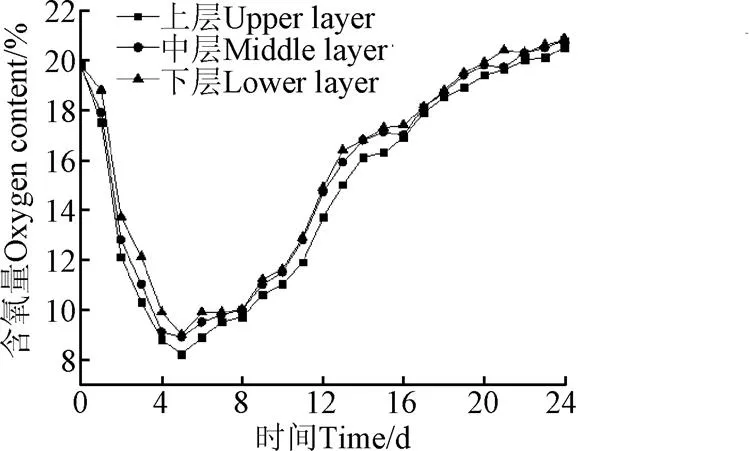
图6 堆肥过程中堆体含氧量的变化曲线
3.4 好氧堆肥过程中堆体物料含水率变化
如图7所示,反应器上、中、下3层的物料含水率,在好氧堆肥过程中,前期,反应器内微生物数量不断增加,消耗的水分量增大,使堆体内含水率下降。到了中后期当微生物繁殖到一定数量后,微生物量会保持相对稳定,消耗与合成的水分量也达到一种动态的平衡,物料含水率趋向于稳定[22]。堆肥过程中,上、中、下3层的物料含水率分别从65.76%下降至42.5%, 42.1% and 41.7%。上、中、下3层含水率差异较小。
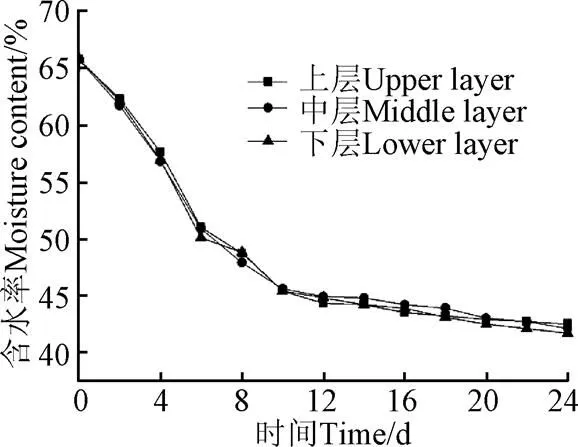
图7 堆肥过程中堆体含水率的变化曲线
3.5 好氧堆肥过程中全碳、全氮、碳氮比(C/N)、全磷与全钾的变化
在好氧堆肥过程中,碳和氮是微生物生长繁殖必要元素。好氧堆肥的实质是通过好氧微生物的生长代谢活动,使有机质分解,因此碳含量处于不断减少的过程中[33],如图8a所示,在堆肥前、中期其下降的速率较快,说明微生物生长繁殖较快,活动频繁,后期趋向于平稳。堆肥过程中,上、中、下3层的物料碳质量分数从39.3%下降至33.8%,33.6% and 33.5%。
牛粪和麦秸秆中的氮含量相对较少,随着好氧堆肥的进行,微生物将氨态氮转变为稳定的硝态氮或亚硝态氮。如图8b所示,为全氮含量的变化曲线,上、中、下3层的物料分别从1.37%提高到2.01%、2.01%、2.03%。在堆肥过程中,随着时间的推移,有机质不断分解成CO2和H2O而逐渐减少,总干物质的下降幅度大于NH3的挥发所引起的下降幅度,最终导致总氮含量增加[28]。
碳氮比是衡量堆肥腐熟的重要指标,堆肥结束后,最终堆肥堆料C/N比值降为15~20时,初步认定堆肥腐熟[23]。由图8c可以看出,上、中、下3层堆料的碳氮比在第14天以后降至20以下,最终的碳氮比分别为:16.8、16.7和16.5。
有图8d、图8e可以看出,全磷、全钾含量呈上升趋势,但增幅不是很明显,这是因为在堆肥过程中,堆体中的P、K不可能通过挥发等形式损失[28]。堆肥过程中,上、中、下3层的物料全磷、全钾分别从0.88% 提高到1.04%、1.03%、1.04%和从1.57%提高到1.74%,1.75%和1.73%。
3.6 好氧堆肥过程中种子发芽指数的变化
种子发芽指数(GI)是判断植物毒性最有效的方法,同时也是衡量好氧堆肥腐熟度的评价指标[34-35]。本试验选第5、10、15、20、24天,上、中、下层堆体物料进行试验,分别测量根长并统计发芽率,结果如图9所示。各层堆料的最终种子发芽指数都大于88%,因此可以认定完全腐熟。
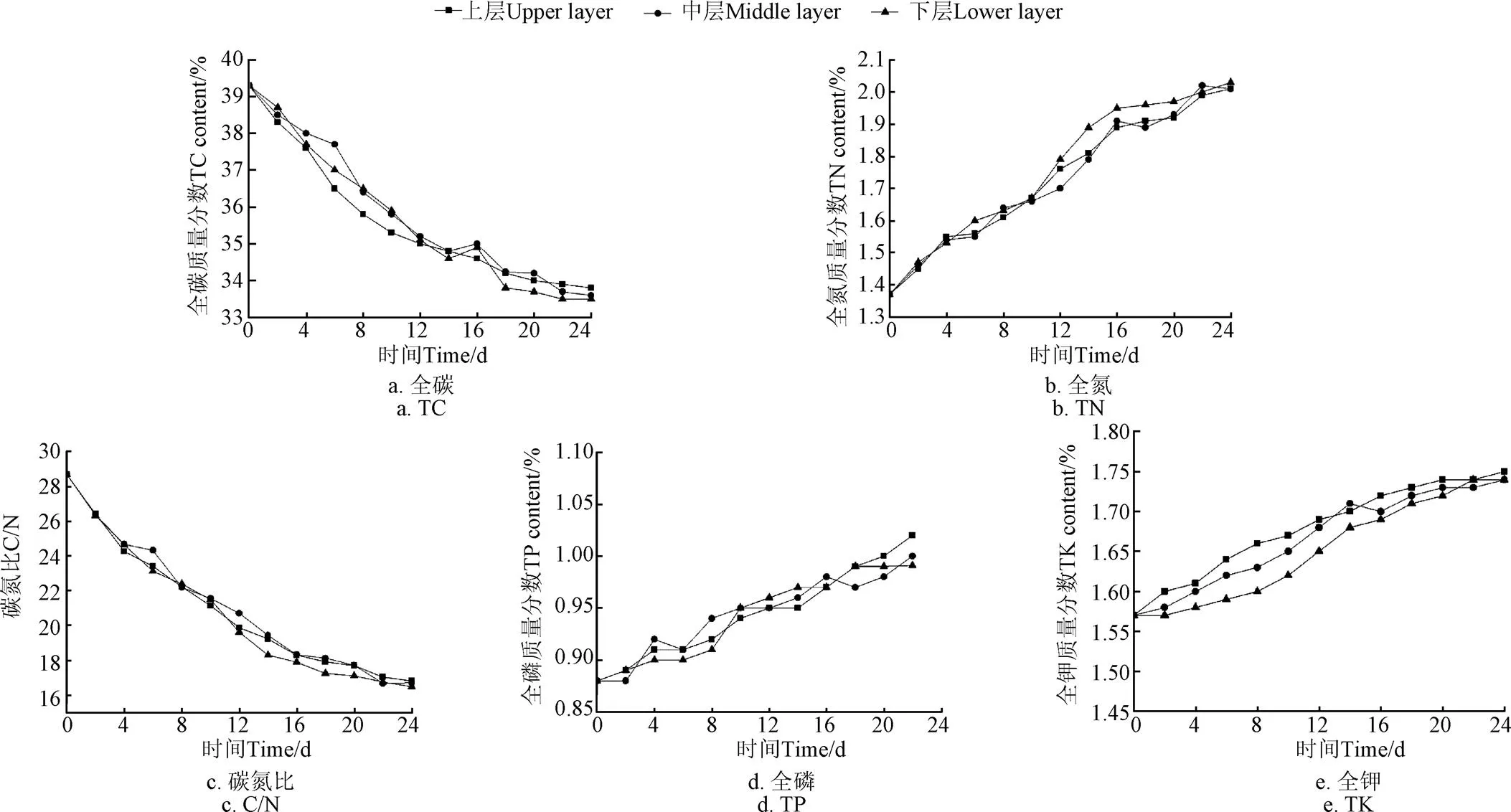
图8 堆肥过程中全碳、全氮、碳氮比、全磷及全钾的变化曲线

图9 堆肥过程中发芽指数的变化曲线
3.7 好氧堆肥前后重金属总量的变化
好氧堆肥过程中,由于微生物分解有机质为CO2、H2O和低分子挥发性有机物而损失,同时重金属含量并不会损失或减少,导致堆肥中重金属含量被相对浓缩而升高[36]。好氧堆肥前后Cu、Zn、Cr、Pb和Cd总量的变化如表2所示,均符合国家农用标准[37]的要求。

表2 堆肥前后重金属总量的变化
4 结 论
1)研制螺带-螺杆式好氧堆肥反应试验装置,反应器有效容积为100 L,采用螺带-螺杆式翻堆结构,促进物料轴向循环,实现均质化反应;
2)建立螺带-螺杆翻堆搅拌模型,通过Fluent软件对反应器内部流场进行数值模拟与分析,验证内部流场具有很好的轴向流动性能;
3)对反应器进行好氧堆肥试验,通过测量堆肥反应过程中堆料上、中、下3层的温度、氧气浓度、全碳含量、全氮含量、碳氮比、全磷含量、全钾含量、种子发芽指数和重金属总量,试验结果表明,上、中、下3层的50 ℃以上的时间分别为7.3、6.8、5.5 d,反应过程中氧气体积分数均大于8%,各层堆料的最终碳氮比介于15~20之间,发芽指数均大于88%,重金属含量符合无害化堆肥的规定,各层的相关指标差异小,因此可进行无害化、均质化好氧堆肥。
[1] Ma Shuangshuang, Fang Chen, Sun Xiaoxi, et al. Bacterial community succession during pig manure and wheat straw aerobic composting covered with a semi-permeable membrane under slight positive pressure[J]. Bioresource Technology, 2018, 259: 221-227.
[2] Mesa F, Torres J, Sierra O, et al. Enhanced production of compost from Andean wetland biomass using a bioreactor and photovoltaic system[J]. Biomass and Bioenergy, 2017, 106: 21-28.
[3] 朱新梦,董雯怡,王洪媛,等. 牛粪堆肥方式对温室气体和氨气排放的影响[J]. 农业工程学报,2017,33(10):258-264.
Zhu Xinmeng, Dong Wenyi, Wang Hongyuan, et al. Effects of cattle manure composting methods on greenhouse gas and ammonia emissions[J]. Transactions of the Chinese Society of Agricultural Engineering(Transactions of the CSAE), 2017, 33(10): 258-264. (in Chinese with English abstract)
[4] 沈玉君,孟海波,张朋月,等. 猪粪堆肥挥发性有机物的产生规律与影响因素[J]. 农业工程学报,2017,33(5):211-216.
Shen Yujun, Meng Haibo, Zhang Mingyue, et al. Generation law and influencing factors of volatile organic compounds during pig manure composting[J]. Transactions of the Chinese Society of Agricultural Engineering(Transactions of the CSAE), 2017, 33(5): 211-216. (in Chinese with English abstract)
[5] 邓良伟,谭小琴,李建,等. 利用秸秆堆肥过程处理猪场废水的研究[J]. 农业工程学报,2004,20(6):255-259.
Deng Liangwei, Tan Xiaoqin, Li Jian, et al. Treatment and reuse of piggery wastewater by composting process of straw[J]. Transactions of the Chinese Society of Agricultural Engineering (Transactions of the CSAE), 2004, 20(6): 255-259. (in Chinese with English abstract)
[6] 孙晓曦,马双双,韩鲁佳,等. 智能型膜覆盖好氧堆肥反应器设计与试验[J]. 农业机械学报,2016,47(12):240-245.
Sun Xiaoxi, Ma Shuangshuang, Han Lujia, et al. Design and test on lab-scale intelligent membrane-covered aerobic composting reactor[J]. Transactions of the Chinese Society for Agricultural Machinery, 2016, 47(12): 240-245. (in Chinese with English abstract)
[7] Edvaldo José Scoton, Rosane Aparecida Gomes Battistelle, Bezerra Barbara Stolte, et al. A sewage sludge co-composting process using respirometric monitoring method in hermetic rotary reactor[J]. Journal of Cleaner Production, 2016, 121: 169-175.
[8] Lu Li-An, Kumar Mathava, Tsai Jen-Chieh, et al. High-rate composting of barley dregs with sewage sludge in a pilot scale bioreactor[J]. Bioresource Technology, 2008, 99(7): 2210-2217.
[9] Osamu Watanabe, Satoru Isoda. Quantitative analysis of microbial biomass yield in aerobic bioreactor[J]. Journal of Environmental Sciences, 2013, 25(Supp.1): S155-S160.
[10] Damian Janczak, Michał Marciniak, Andrzej Lewicki, et al. Bioreactor internet system for experimental data monitoring and measurement[J]. Procedia Technology, 2013, 8: 209-214.
[11] He Xueqin, Han Lujia, Ge Jinyi, et al. Modelling for reactor-style aerobic composting based on coupling theory of mass-heat-momentum transport and Contois equation[J]. Bioresource Technology, 2018, 253: 165-174.
[12] Zambra C E, Moraga N O. Heat and mass transfer in landfills: Simulation of the pile self-heating and of the soil contamination[J]. International Journal of Heat and Mass Transfer, 2013, 6: 324-333.
[13] Zambra C E, Muñoz J F, Moraga N O. A 3D coupled model of turbulent forced convection and diffusion for heat and mass transfer in a bioleaching process[J]. International Journal of Heat and Mass Transfer, 2015, 85: 390-400.
[14] Zambra C E, Moraga N O, Rosales C, et al. Unsteady 3D heat and mass transfer diffusion coupled with turbulent forced convection for compost piles with chemical and biological reactions[J]. International Journal of Heat and Mass Transfer, 2012, 55(23/24): 6695-6704.
[15] 张安琪,黄光群,张绍英,等. 好氧堆肥反应器试验系统设计与性能试验[J]. 农业机械学报,2014,45(7):156-161.
Zhang Anqi, Huang Guangqun, Zhang Shaoying, et al. Design and test on an experimental aerobic composting reactor system[J].Transactions of the Chinese Society for Agricultural Machinery, 2014, 45(7): 156-161. (in Chinese with English abstract)
[16] 吕黄珍,韩鲁佳,张锐. 试验室好氧堆肥反应器系统性能试验[J]. 农业机械学报,2008,39(1):91-96.
Lü Huangzhen, Han Lujia, Zhang Rui. Experimental investigation on the performance of laboratory-scale aerobic composting reactor system[J]. Transactions of the Chinese Society for Agricultural Machinery, 2008, 39(1): 91-96. (in Chinese with English abstract)
[17] Guillermo Vidriales-Escobar, Raul Rentería-Tamayo, Felipe Alatriste-Mondragón, et al. Mathematical modeling of a composting process in a small-scale tubular bioreactor[J]. Chemical Engineering Research and Design, 2017, 120: 360-371.
[18] Naoto Shimizu, Joko Nugroho, Wahyu Karyadi, et al. Cattle manure composting in a packed-bed reactor with forced aeration strategy[J]. Engineering in Agriculture, Environment and Food, 2018, 11(2): 65-73.
[19] Lashermes G, Barriuso E, Le Villio-poit Renaud M, et al. Composting in small laboratory pilots[J]. Waste Management, 2012, 32(2): 271-277.
[20] 席北斗,刘鸿亮,孟伟,等. 翻转式堆肥反应装置设计研究[J]. 环境污染治理技术与设备,2003,4(9):85-88.
Xi Beidou, Liu Hongliang, Meng Wei, et al. Research on the design of a rotation composting reactor for municipal solid waste composting[J]. Techniques and Equipment for Environmental Pollution Control, 2003, 4(9): 85-88. (in Chinese with English abstract)
[21] 戴芳,曾光明,袁兴中,等. 新型堆肥装置设计及其应用研究[J]. 环境污染治理技术与设备,2005(2):24-28.
Dai Fang, Zeng Guangming, Yuan Xingzhong, et al.Design of a new type of composting device and its application[J]. Techniques and Equipment for Environmental Pollution Control, 2005(2): 24-28. (in Chinese with English abstract)
[22] 迟文慧. 梨形筒式好氧堆肥反应器的开发与试验研究[D]. 西安:西安建筑科技大学,2012.
Chi Wenhui. Development and Application of a Pyriform Rotating Drum Reactor for Aerobic Composting in Pilot Scale[D]. Xi’an: Xi’an University of Architecture and Technology, 2012. (in Chinese with English abstract)
[23] 杨杰,郑国香,赵欣,等. 强化堆料径向流动好氧堆肥反应器设计及性能[J]. 农机化研究,2017,39(11):223-228.
Yang Jie, Zheng Guoxiang, Zhao Xin, et al. Design and performance assessment of an aerobic composting reactor for enhancing radially blending[J]. Journal of Agricultural Mechanization Research, 2017, 39(11): 223-228. (in Chinese with English abstract)
[24] 陈志平,章序文. 搅拌与混合设备设计选用手册[M]. 北京:化学工业出版社,2004.
[25] 李星. C50堆肥反应器的研究设计[D]. 北京:中国农业机械化科学研究院,2015.
Li Xing. Design and Research of C50 Compost Bioreactor[D]. Beijing: Chinese Academy of Agricultural Mechanization Sciences, 2015. (in Chinese with English abstract)
[26] 张敏革,张吕鸿,姜斌,等. 双螺带-螺杆搅拌桨在不同流体中的搅拌流场特性[J]. 天津大学学报,2009,42(10):884-890.
Zhang Minge, Zhang Lühong, Jiang Bin, et al. Performance of flow field in different fluids stirred with double helical ribbon and screw impeller[J]. Journal of Tianjin University, 2009, 42(10): 884-890. (in Chinese with English abstract)
[27] 杨延梅. 有机固体废物好氧堆肥反应器的设计[J]. 重庆交通大学学报:自然科学版,2008,27(6):1155-1159.
Yang Yanmei. The design of the organic solid wastes compost equipment[J]. Journal of Chongqing Jiaotong University: Natural Science, 2008, 27(6): 1155-1159. (in Chinese with English abstract)
[28] 施宠,张小娥,沙依甫加玛丽,等. 牛粪堆肥不同处理全N、P、K及有机质含量的动态变化[J]. 中国牛业科学,2010,36(4):26-29.
Shi Chong, Zhang Xiao’e, Shayifujiamali, et al. Dynamic changes of total N, P, K and organic matter by different treatments on cattle manure composting[J]. China Cattle Science, 2010, 36(4): 26-29. (in Chinese with English abstract)
[29] 葛骁,李买军,张盛华,等. 调理剂对堆肥产品重金属生物有效性的影响[J]. 环境工程学报,2014,8(7):3047-3052.
Ge Xiao, Li Maijun, Zhang Shenghua, et al. Effect of conditioners on bioavailability of heavy metals in sludge compost[J]. Chinese Journal of Environmental Engineering, 2014, 8(7): 3047-3052. (in Chinese with English abstract)
[30] 粪便无害化卫生要求:GB 7959-2012[S].
[31] Zambra C E, Rosales C, Moraga N O, et al. Self-heating in a bioreactor: Coupling of heat and mass transfer with turbulent convection[J]. International Journal of Heat and Mass Transfer, 54(23/24): 5077-5086.
[32] Hamelers H V M. A Mathematical Model for Composting Kinetics[D]. Wageningen: Wageningen University, 2011.
[33] 王永江. 猪粪堆肥过程有机质降解动力学模型研究[D]. 北京:中国农业大学,2014.
Wang Yongjiang. Study on Degarding Kinetic of Organic Matter for Composting Process of Swine Manure[D]. Beijing: China Agricultural University, 2014. (in Chinese with English abstract)
[34] Luo Yuan, Liang Jie, Zeng Guangmin, et al. Seed germination test for toxicity evaluation of compost: Its roles, problems and prospects [J]. Waste Management, 2018, 71: 109-111.
[35] Hiarhi Monda, Vincenza Cozzolino, Giovanni Vinci, et al.
Molecular characteristics of water-extractable organic matter from different composted biomasses and their effects on seed germination and early growth of maize[J]. Science of the Total Environment, 2017, 590/591: 40-49.
[36] Ciavatta C, Govi M, Simoni A, et al. Evaluation of heavy metals during stabilization of organic matter in compost produced with municipal solid wastes[J]. Bioresource Technology, 1993, 43(2): 147-153.
[37] 农用污泥中污染物控制标准:GB4284-2018[S].
Development and its application effect of aerobic compost bioreactor with helical ribbon and screw impeller
Miao Hong1,2, Yang Zheng1, Wang Meng1, Chen Xuehao3, Zhang Ruihong1, Liu Sixing1
(1., 225000,; 2.210014,; 3.225000,)
In recent years, with the rapid development of the poultry industry in China, it has brought enormous challenges to the ecological environment. The reduction, recycling and innocuous treatment of these organic solid wastes can be achieved by aerobic composting. The vertical reactor has a simple structure, effectively shortens the compost reaction time and improves the composting reaction environment. Therefore, the aerobic compost reactor has good practical value. However, due to the gravity accumulation of the material, the reactor has some problems, such as compacted material, poor ventilation, high ventilation resistance, and difficulty in homogenizing the product. In order to solve these problems, spiral-belt-spiral-impeller aerobic compost bioreactor was designed with real-time monitoring of insulation, temperature and oxygen content. This reactor has a volume of 100 L. Computational fluid dynamics method was used to analyze the flow field within the reactor. The 3D solid modeling of the internal flow field model in the reactor was completed by Soildworks modeling, and the MRF(multiple reference frame) method was used to deal with the interaction between the stationary reactor inner wall and the moving stirring blade. The analysis of the velocity field distribution and velocity vector on the=0 section demonstrated that the reactor had good axial flow through the internal velocity distribution. The performance of the reactor was studied in aerobic composting test. The raw materials for composting were cow manures, wheat straw and mushroom residues, and the total reaction time was 24 days. The reaction was evaluated by measuring the temperature, oxygen concentration, total carbon, total nitrogen, C/N, total phosphorus, total potassium, germination index, total heavy metals and sensory indicators in the upper, middle and lower layers of the reactor. During the composting reaction process, the performance of aerobic composting test showed that the upper, middle and lower temperatures above 50℃ were 7.3, 6.8, 5.5 days, respectively, and the temperature first increased and then decreased. The oxygen concentration during the reaction was higher than 8%. The lowest value appeared around the fourth day. In the aerobic composting process, the moisture content and total carbon content showed a downward trend, while the total nitrogen content, total phosphorus content and total potassium content showed an upward trend. The moisture content gradually decreased from 65.76% to 42.5%, 42.1% and 41.7%, the carbon content decreased from 39.3% to 33.8%, 33.6% and 33.5%, the total nitrogen content increased from 1.37% to 2.01%, 2.01% and 2.03%, the total phosphorus content increased from 0.88% to 1.04%, 1.03% and 1.04%, the total potassium content increased from 1.57% to 1.74%, 1.75% and 1.73%, which were related to the law of microbial activity in the reactor. After composting, it has no obvious foul smell compared with the initial heap. The C/N of each layer was between 15 and 20, and the germination index was greater than 88%. The heavy metals such as Cu, Zn, Cr, Pb and Cd met the national standards. Therefore, the reactor could achieve harmless and uniform compost.
composting; equipment; performance test; helical ribbon and screw impeller; bioreactor
缪 宏,杨 铮,王 蒙,陈学好,张瑞宏,刘思幸. 螺带-螺杆式搅拌好氧堆肥反应器研制及应用效果[J]. 农业工程学报,2018,34(24):232-238. doi:10.11975/j.issn.1002-6819.2018.24.028 http://www.tcsae.org
Miao Hong, Yang Zheng, Wang Meng, Chen Xuehao, Zhang Ruihong, Liu Sixing. Development and its application effect of aerobic compost bioreactor with helical ribbon and screw impeller[J]. Transactions of the Chinese Society of Agricultural Engineering (Transactions of the CSAE), 2018, 34(24): 232-238. (in Chinese with English abstract) doi:10.11975/j.issn.1002-6819.2018.24.028 http://www.tcsae.org
2018-06-11
2018-10-02
江苏省科技计划项目(BE2016346);农业部现代农业装备重点实验室开放基金项目(HT20160359);江苏省自然科学基金项目(20170500,18KJB460032);江苏省农业“三新工程”项目(NJ2018-07);扬州市科技项目(YZ2017052,YZ2017279);扬州大学科技创新基金项目(2017CXJ021)扬州大学研究生培养创新工程项目(XKYCX17_042)
缪 宏,副教授,博士,主要从事生物质资源化利用技术、智能农业方面的研究。Email:mh0514@163.com
10.11975/j.issn.1002-6819.2018.24.028
S491
A
1002-6819(2018)-24-0232-07
